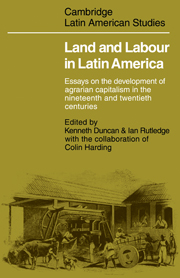 Land and Labourin Latin America
Land and Labourin Latin America Book contents
- Frontmatter
- Contents
- List of tables
- List of figures
- List of maps
- Acknowledgements
- 1 Introduction: patterns of agrarian capitalism in Latin America
- PART I THE TRANSITION FROM TRADITIONAL HACIENDA TO CAPITALIST ESTATE
- 2 Hacienda profits and tenant farming in the Mexican Bajío, 1700–1860
- 3 Landlord, labourer, and tenant in San Luis Potosí, northern Mexico, 1822–1910
- 4 Land and labour in rural Chile, 1850–1935
- 5 The development of the Chilean hacienda system, 1850–1973
- 6 Relations of production in Andean haciendas: Peru
- 7 The formation of the coffee estate in nineteenth-century Costa Rica
- PART II THE DEVELOPMENT OF A PLANTATION ECONOMY WITH LABOUR RECRUITMENT FROM HIGHLAND PEASANT COMMUNITIES
- PART III THE DEVELOPMENT OF COMMERCIAL AGRICULTURE USING EUROPEAN IMMIGRANT LABOUR
- PART IV THE TRANSITION FROM SLAVE PLANTATION TO CAPITALIST PLANTATION
- PART V POSTSCRIPT
- Glossary of Spanish and Portuguese terms used in the text
- Weights and measures
- Notes on contributors
- Indexes Subjects
- Authors
3 - Landlord, labourer, and tenant in San Luis Potosí, northern Mexico, 1822–1910
Published online by Cambridge University Press: 07 May 2010
- Frontmatter
- Contents
- List of tables
- List of figures
- List of maps
- Acknowledgements
- 1 Introduction: patterns of agrarian capitalism in Latin America
- PART I THE TRANSITION FROM TRADITIONAL HACIENDA TO CAPITALIST ESTATE
- 2 Hacienda profits and tenant farming in the Mexican Bajío, 1700–1860
- 3 Landlord, labourer, and tenant in San Luis Potosí, northern Mexico, 1822–1910
- 4 Land and labour in rural Chile, 1850–1935
- 5 The development of the Chilean hacienda system, 1850–1973
- 6 Relations of production in Andean haciendas: Peru
- 7 The formation of the coffee estate in nineteenth-century Costa Rica
- PART II THE DEVELOPMENT OF A PLANTATION ECONOMY WITH LABOUR RECRUITMENT FROM HIGHLAND PEASANT COMMUNITIES
- PART III THE DEVELOPMENT OF COMMERCIAL AGRICULTURE USING EUROPEAN IMMIGRANT LABOUR
- PART IV THE TRANSITION FROM SLAVE PLANTATION TO CAPITALIST PLANTATION
- PART V POSTSCRIPT
- Glossary of Spanish and Portuguese terms used in the text
- Weights and measures
- Notes on contributors
- Indexes Subjects
- Authors
Summary
In northern Mexico, where population was sparse and land plentiful, large estates predominated; their size, roughly speaking, increased with aridity and distance from Mexico City. In the state of San Luis Potosi, situated in what might be called the middle north, haciendas covered an average area of about fifteen square leagues; that is, between 25,000 and 30,000 hectares each. The few Indian villages that existed – there had been no sedentary population in northern Mexico before the Conquest – were also well endowed with land, some of them originally having been granted some thirty-six square leagues each by the colonial government. Estates naturally made frequent inroads into these communal holdings, thereby expanding at the expense of the Indian villages. The opposite process also took place occasionally, at least after Mexico became independent in 1821.
The population of the old-established Indian villages was not very large, and it would seem that in the early nineteenth century they did not supply the haciendas with much of the required seasonal labour; instead the estates had to rely almost entirely on their own permanent labourers. Another source of seasonal labour arose in time, eventually replacing the old villages. The estates were enormous, and in the beginning only the land around the casco – the farm buildings – was cultivated, and the rest was given over to extensive cattle-grazing. The peones or farm labourers lived in the casco, leaving the rest of the estate virtually uninhabited, except for a few small, scattered ranches where the cattle herds were kept and where the herders lived.
- Type
- Chapter
- Information
- Land and Labourin Latin AmericaEssays on the Development of Agrarian Capitalism in the nineteenth and twentieth centuries, pp. 59 - 82Publisher: Cambridge University PressPrint publication year: 1978


